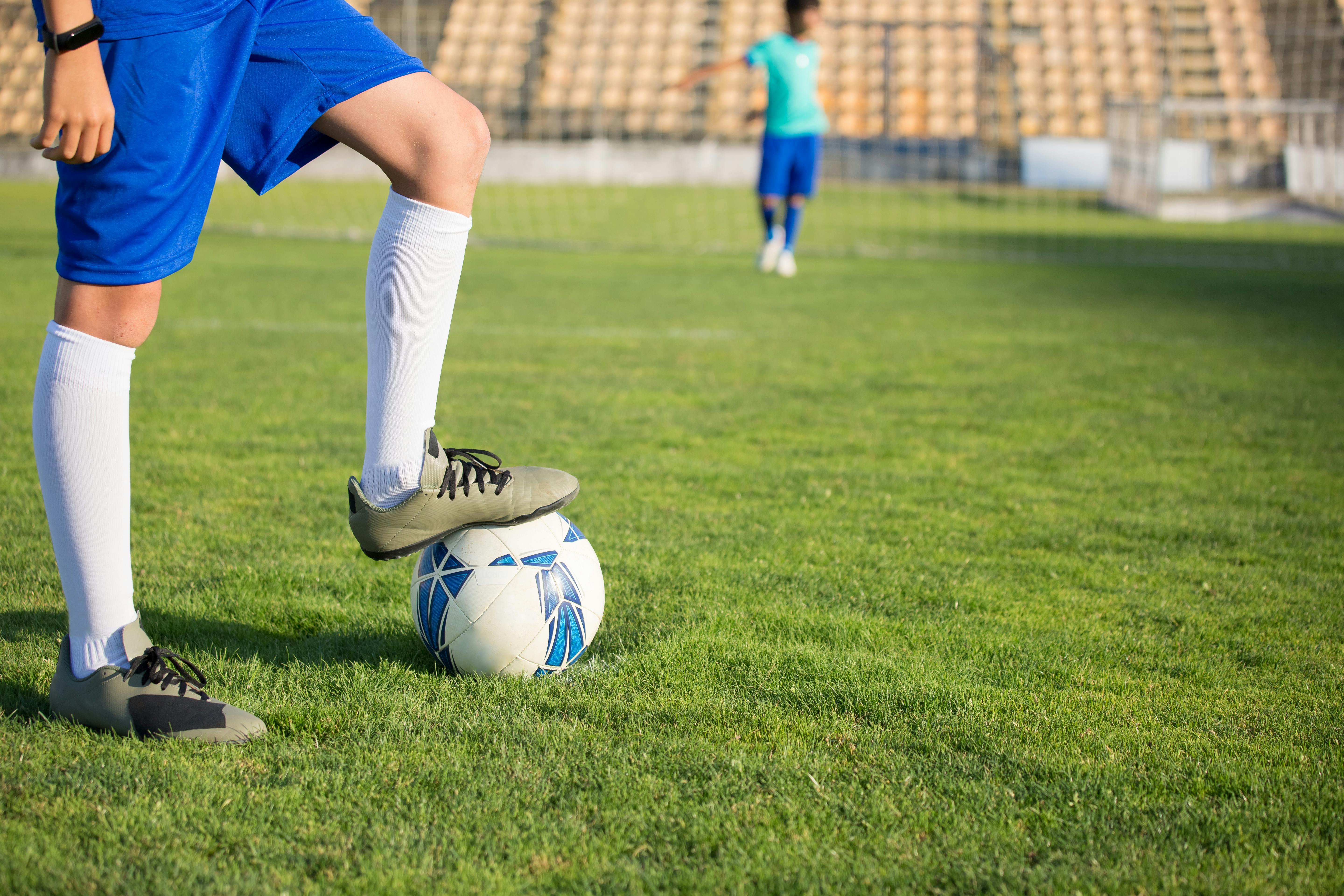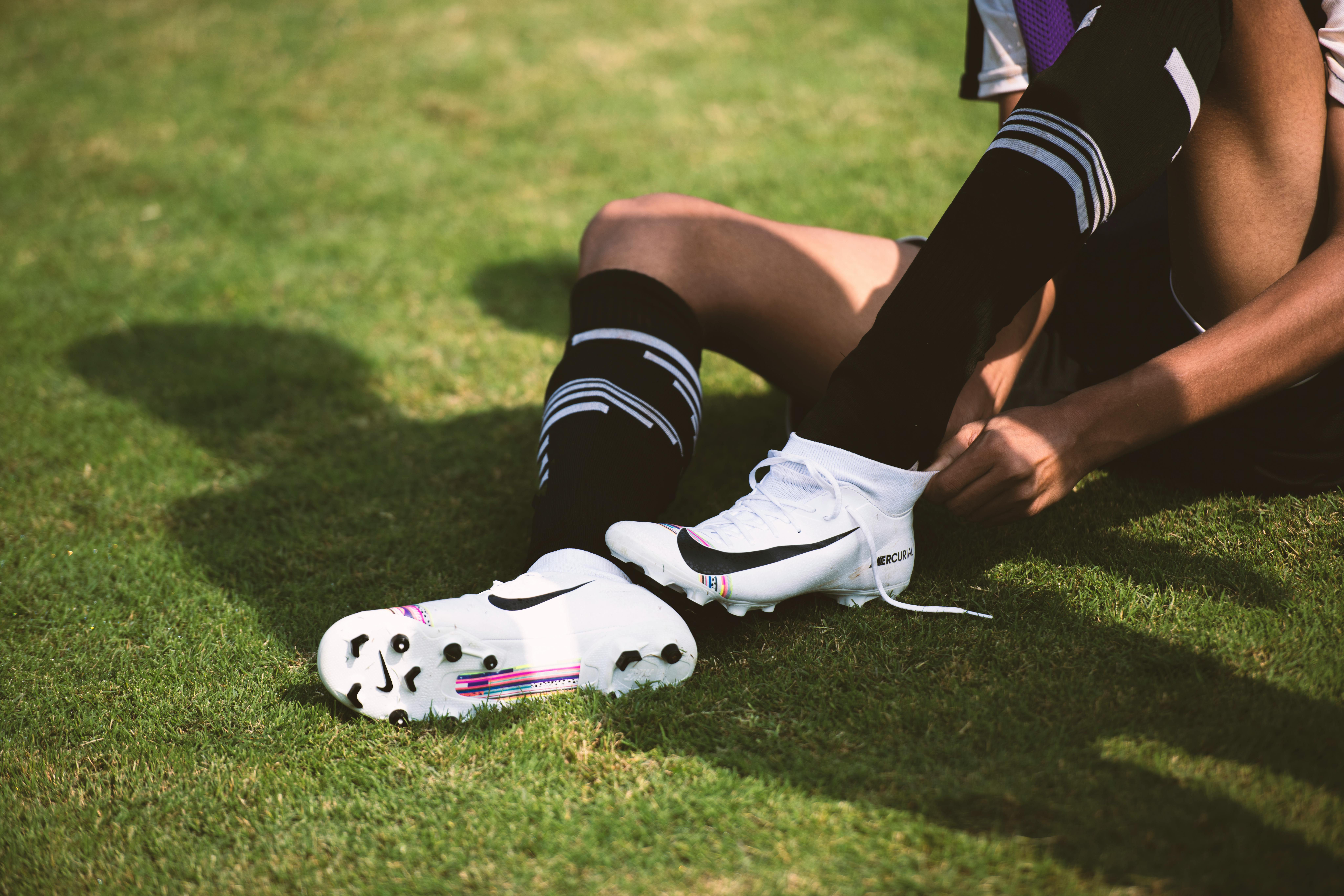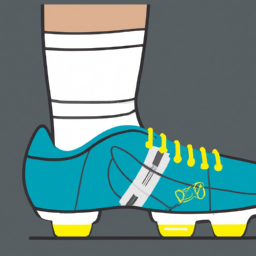Breaking in soccer cleats is an important part of getting the most out of your shoes. This process allows you to form the cleats to your feet, making them more comfortable and giving you better control on the field. Before you hit the pitch, it’s important to take the time to break in your cleats so you can enjoy all of their benefits. With this guide, you will learn how to break in your soccer cleats so they fit perfectly and feel comfortable on your feet.1. Soak the cleats in warm water for 15-20 minutes.
2. Remove the cleats from the water and use a soft bristle brush to remove any dirt or debris from the upper surface.
3. Rub a small amount of petroleum jelly into the leather upper of the cleats and leave them to sit for 10 minutes.
4. Put on a pair of thick socks and put on your cleats while they’re still damp.
5. Take a hair dryer set on low heat and blow it onto your feet while wearing the cleats until they are completely dry.
6. Once dry, remove them and apply another thin layer of petroleum jelly, concentrating on areas that feel stiff or uncomfortable against your feet.
7. Allow them to sit overnight with a newspaper stuffed inside each one to help absorb moisture and soften them up further as they dry out overnight
What Type Of Soccer Cleats Are Best For Breaking In?
When looking for cleats that are best for breaking in, it is important to consider the type of material they are made from. Leather is the most popular choice, as it provides a comfortable and natural fit that conforms to your foot shape over time. Synthetic materials are lightweight and generally more affordable, but don’t provide the same level of comfort or customization. It is also important to consider the soleplate of your cleats; some offer more flexibility than others, allowing you to move around the pitch with greater ease. Ultimately, it comes down to personal preference and finding a pair that fits your needs.
It is also important to consider the shape of your cleats when selecting the best option for breaking in. The most common types are low-cut, mid-cut, and high-cut cleats. Low cut cleats offer more flexibility and less ankle support than their mid or high cut counterparts – ideal for making quick changes in direction on the pitch. Mid and high-cut cleats provide greater support at the ankle but can be heavier and less flexible – better suited for players who need extra stability when playing on uneven surfaces or when making strong tackles. Again, it comes down to personal preference as all three styles can be broken in over time.
Finally, when looking for soccer cleats that are best for breaking in, it is important to find a pair with good padding around the heel area. This will provide comfort during play and help prevent blistering on longer games. Look for a pair with cushioning at pressure points like toes and heels as this will help reduce impact while playing on hard surfaces such as concrete or turf fields. This will also help ensure proper fitment over time with minimal wear and tear on your feet while playing soccer.
Making Soccer Cleats More Comfortable
Wearing soccer cleats can be uncomfortable, but there are several ways to make them more comfortable. The first step is to make sure that the cleats fit properly. Choose a pair that fits snugly and does not feel too tight or too loose. If they do not fit properly, it can lead to blisters and other pain that can be avoided. It is also important to wear the right kind of socks with your cleats. Choose socks made from a material that wicks away moisture, such as polyester or nylon, which will keep your feet dry and prevent blisters.
The next step is to break in your soccer cleats before you wear them in a game. Wear them around the house for a few hours at first, then take them out on the field for practice sessions to make sure they are comfortable before wearing them in an actual game. This will help the shoe material conform to your foot shape and reduce any discomfort you might experience when playing in them for an extended period of time.
You should also use some type of cushioning insole with your soccer cleats if possible. This will provide extra cushioning and support for your feet while playing, and can help reduce some of the pain associated with playing soccer in traditional cleats. You can also try using tape on any pressure points that may be causing discomfort when wearing the shoes.
Finally, remember to take care of your soccer cleats by cleaning and drying them after each use. This will ensure that they stay comfortable for as long as possible and help prevent any damage or wear and tear from occurring over time. With these tips, you’ll be able to make wearing soccer cleats more comfortable so you can play without worrying about discomfort or blisters.
Should You Wear Socks With Soccer Cleats?
When it comes to playing soccer, the right footwear is essential. Soccer cleats are designed for maximum comfort and traction on the field, and wearing them with socks is a great way to ensure that you get the most out of your shoes. Wearing socks with soccer cleats can prevent blisters, wick away moisture to keep your feet dry, and provide an extra layer of cushioning for your feet.
When choosing socks for soccer, it’s important to look for a pair that is specifically designed for sports. Athletic socks are generally made from materials that help keep your feet dry while providing enough cushioning that you won’t feel every pebble or blade of grass on the field. A good pair of athletic socks should also fit snugly without being so tight that they leave marks on your skin after you take them off.
It’s also important to make sure that your soccer cleats fit properly when you wear them with socks. The right size will keep your feet from sliding around inside the shoe and can help prevent injuries like blisters or sprains. If you don’t know what size cleats you need, try on a few different pairs before making a purchase.
In addition to preventing blisters and other injuries, wearing socks with soccer cleats can also help protect your feet from dirt and other debris while you’re playing. When dirt gets inside your shoe, it can rub against your skin and cause irritation or even infection if not washed away quickly. Wearing a pair of athletic socks will help keep any dirt or debris from getting inside your shoe without having to constantly stop to clean out the inside of the shoe during a game.
All in all, wearing socks with soccer cleats is highly recommended for anyone who wants maximum comfort and performance on the field. Athletic socks are designed specifically for sports wear and provide an extra layer of protection against dirt, debris and injury while keeping your feet dry during playtime. Be sure to find the right size cleat that fits comfortably when worn with athletic socks so that you can enjoy every moment of playtime without having to worry about blisters or discomfort!
How To Reduce Blisters From Wearing Soccer Cleats
Wearing the wrong size of soccer cleats can be a major cause of blisters. It is important to get the right size of soccer cleats that fit your feet snugly and comfortably. You should also make sure to break in the cleats before wearing them during a game or practice. This can help prevent discomfort and blisters caused by rubbing. Additionally, you should wear cleat covers or use medical tape to secure your socks to the cleats. This will help reduce friction and thus, prevent blisters from forming. Moreover, it is important to wear socks that are designed for soccer cleats as they are thicker than regular socks which will provide more cushioning and limit friction. You should also apply lubricant on your feet before putting on the socks and cleats. This will help to reduce any rubbing between your feet and the material of your shoes which can lead to blistering. Finally, it is important to stay hydrated while playing soccer as this helps keep your skin moist which can limit any potential blistering.

How To Stretch Your Soccer Cleats For A Better Fit
Stretching your soccer cleats is an important part of ensuring that they fit properly. Having a pair of cleats that fit correctly can help reduce the risk of injury and improve your performance on the field. Many people are unsure how to go about stretching their cleats, so this article will provide some tips on how to do it properly.
The first step is to find a shoe stretcher or something that can be used to stretch the cleats. This could be anything from a wooden spoon to a pair of pliers or even a hairdryer. It’s important to make sure the device you use is strong enough and won’t damage your soccer cleats in any way.
Once you have the appropriate tool, you’ll want to start by inserting it into the shoe and working it back and forth until you feel the material start to give. Keep doing this until you’re satisfied with how much the cleats have stretched. Make sure not to overstretch them, as this can damage them permanently.
You can also try using a heat source such as a hairdryer or heat gun if you don’t have access to a shoe stretcher. Just make sure not to get too close with the heat source as this could cause damage or even melt the material in some cases.
It’s also important to note that stretching your soccer cleats isn’t just about making them fit better, but also about helping them last longer. By stretching them regularly, you’ll ensure that they stay in good condition for longer and don’t wear out prematurely due to poor fit or lack of flexibility.
In conclusion, stretching your soccer cleats is an important part of keeping them in good shape and making sure they give you maximum performance on the field. Make sure to use an appropriate tool and take care not to overstretch them as this could cause permanent damage. With these tips in mind, you should be able to stretch your cleats for a better fit in no time!
It Is Best To Wear Your Soccer Cleats Tight
When it comes to soccer cleats, it is best to wear them tight. This helps to ensure that your foot is secure while playing and prevents your foot from slipping inside the cleat. Wearing the cleat too loose can create an uncomfortable fit, and can also lead to blisters on the feet as the material of the cleat rubs against your skin. Additionally, if the cleat is too loose you may not have enough stability in your ankle, which can lead to injuries.
The best way to make sure your cleats fit correctly is to try them on before purchasing. Make sure you walk around in them and even do some light running or jumping. If you don’t feel secure in them, they may be too loose or too tight and should be adjusted accordingly before purchasing. It’s also important to make sure that the laces are properly secured so that they don’t come undone during a game.
In addition, it’s important to pay attention to what type of soccer cleats you are buying. Different types of cleats offer different levels of support and stability depending on what position you play and what type of field you are playing on. Make sure that you buy a pair of soccer shoes that are designed for the position you play and for the field surface you will be playing on. This will help ensure that your feet stay secure throughout the game, while also providing optimal performance from your shoes.
How Does Weather Affect The Fit Of Your Soccer Cleats?
The weather can have a significant effect on the fit of your soccer cleats. In colder temperatures, your feet will naturally shrink which can cause the cleats to feel tight and uncomfortable. In addition, leather cleats may become stiff in cold weather, making them difficult to break in and uncomfortable for extended periods of wear. In wet weather, your feet may swell which can make the cleat feel loose. It is important to keep this in mind when selecting a size for your cleats and to make sure you wear the correct size that will fit comfortably when playing in any type of weather conditions.
To ensure proper fit and maximum comfort, it is recommended that you purchase a pair of soccer cleats that are slightly larger than your regular shoe size. This allows for some additional room in case your feet swell due to wet or hot conditions while playing or practicing. It’s also important to consider how much you plan on wearing your cleats. If you are only going to be wearing them occasionally, you may want to go with a smaller size as lower-cut cleats tend to stretch over time and could become too loose if worn often.
In order to get the most out of your soccer cleats it is important to select a pair that fits properly no matter what the weather conditions may be. By taking into account the temperature, wetness, and amount of use you will be getting out of them – you can ensure that your soccer shoes are comfortable and supportive throughout each match or practice session.

Conclusion
Breaking in your soccer cleats is an important step. Not only does it help you get the most out of your cleats, it also helps to protect your feet from blisters, bruising and other potential injuries. The best way to break in your soccer cleats is to wear them for short periods of time and gradually increase the duration as your feet become more accustomed to them. You can also use socks, ball screens or a shoe stretcher to help break in your cleats faster. With a little bit of patience and effort, you’ll be able to play with confidence and comfort knowing that your soccer cleats are properly broken in.
Ultimately, breaking in your soccer cleats is about finding what works best for you and then making the necessary adjustments accordingly. By following the tips outlined above, you’ll be able to create a breaking-in process that’s tailored specifically for you and helps ensure that you get the most out of your cleats.

